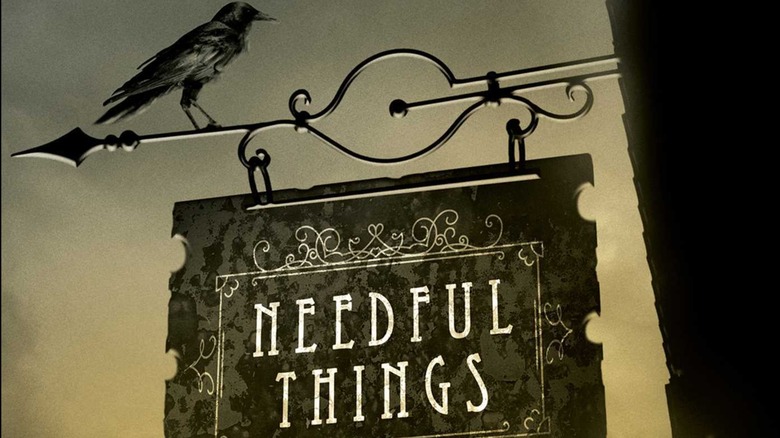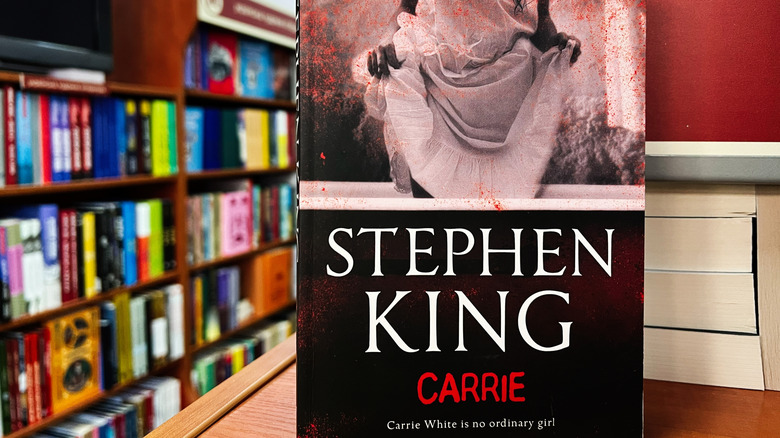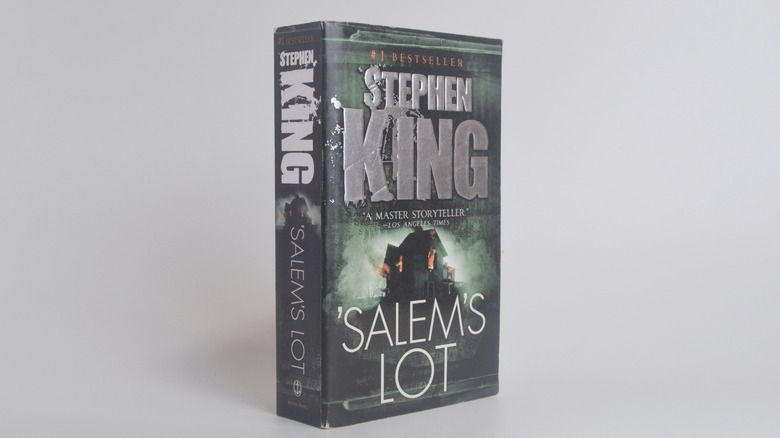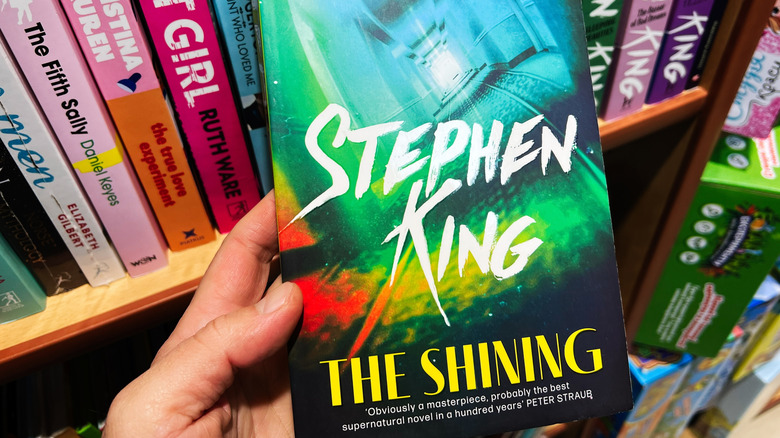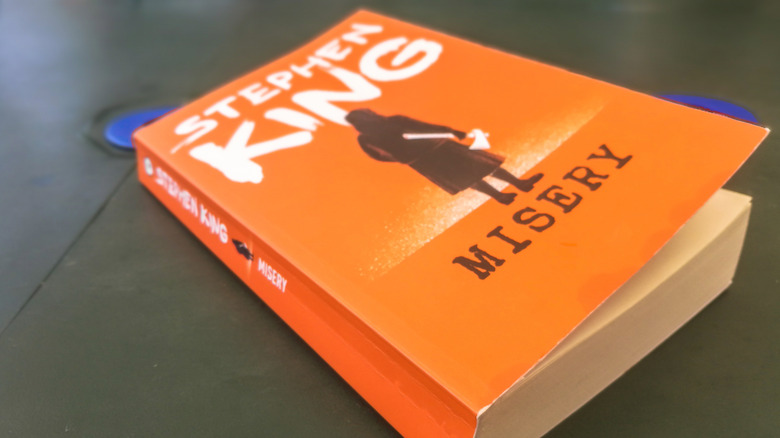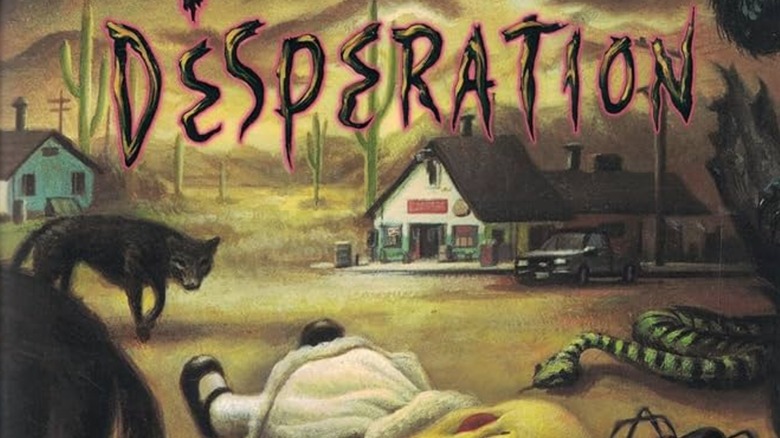10 Scariest Stephen King Books Ranked
Stephen King has enjoyed a prolific career as our modern master of horror. That success begins with the former Maine schoolteacher's examination of adolescent cruelty in his first novel — and first bestseller — "Carrie." Its impact led to an interconnected universe of horror, fantasy, crime, and even science fiction that, today, make up Stephen King's multiverse: a sprawling fictional galaxy where the Dark Tower isn't the only fixed point its inhabitants are all too aware of.
In his decades of success, King has written hundreds of short stories and novels, many of which have made their way onto screens big and small, and led to some of the scariest movie bad guys ever dreamed up. From Annie Wilkes, to the smiley-face-button-wearing Randall Flagg, there's a nightmare for every one of his constant readers.
Between the pages of King's books exist a host of horrors: old world vampires, frightening liminal spaces, an apocalyptic plague, and, perhaps most frightening of all, teenage angst. Not one to rest on his laurels, the literary legend continues to churn out books almost annually. In his long and impressive bibliography, here are the top ten books that fans say left them sleeping with the lights on.
10. Needful Things
One man's trash is another woman's treasure, and junk store lovers know there's nothing quite like browsing through a collection of other people's discarded goods. But as Stephen King's 1991 novel "Needful Things" warns us, it's not always the worst idea to pass up a deal that seems too good to be true.
"Needful Things" takes place in Castle Rock, Maine, the preternatural setting of several of King's tales, as well as being the titular community in the canceled King multiverse mashup "Castle Rock." That show was billed as the last of the Castle Rock stories at the time, a title that's far from true today. Anyway, fortune smiles upon the good people of Castle Rock when a cute new shop opens up in town, run by a charming fellow who goes by the slightly sinister-sounding name Leland Gaunt.
What makes this shop so special? It has exactly what you want — no matter what that happens to be. Want a vintage carnival glass lampshade? Gaunt has it. An obscure baseball card? No problem. His prices are bargain basement, too — that is, as long as you're willing to play a simple little prank on other Castle Rock residents, per Gaunt's instructions. Far more than mere mischief-making, Gaunt's "pranks" soon begin to escalate into bloody mayhem, revealing the machinations of a chaos agent with a vast knowledge of the town's darker secrets. Violent, bleak, and terrifying, this book is one of the most chilling tales in the King compendium.
9. Carrie
The novel that started it all, 1974's "Carrie," has seen two film adaptations, a sequel, and a musical adaptation. It still stands as one of the author's strongest and most terrifying stories, probably because the horror comes from those all-too human harms done by people surrounding the central character. No monsters under this bed.
The story follows the tragic life and death of Carrietta "Carrie" White, a Maine teenager who suffered 16 years of abuse at the hands of her religious zealot mother, a woman who perceived all of sex and puberty as the evils of the Devil. Like many other characters in King's multiverse, Carrie has the power of telekinesis, or the "TK gene" as it's called in King's recent TV adaptation "The Institute." Carrie's life goes from bad to worse when the girl, who has never been taught the facts of life, experiences her first period at school. This causes a full-blown panic attack, followed by a brutal mocking. Her torment was led by the school's resident mean girl, Chris Hargensen, who sets out to further harass Carrie when she faces discipline over her own behavior. Things turn south for all of Carrie's tormentors, however, when she realizes she actually has the upper hand.
More disturbing than spooky-scary, "Carrie" is a censure against turning a blind eye to the pain and suffering of others, or writing off what happens behind someone else's closed doors. The true terror of this tale is what happens to Carrie — bullying, teenage despair, and all.
8. The Stand
Clocking in at well over 1000 pages long, "The Stand" is one of King's longest and most epic books. Although it's one of King's scariest stories, it's actually not much of a horror novel. The "horror" is mostly contained in the first part, as the world falls apart due to an apocalyptic virus. The collapse is just one component of a dark fantasy saga that sees the human race forced into a reset, with a devilish twist.
The novel, which shifts perspectives among a rather lengthy cast of characters across the spectrum of good and evil, begins with an engineered superflu colloquially known as "Captain Trips" escaping from a military base and scourging its way across the country. The flu wipes out more than 99 percent of humanity within weeks, with all the breakdowns that would create.
The descriptions of a world laid waste by a microscopic foe are nightmare fuel. It was terrifying when the book was released in 1978, but it hits a little bit different after experiencing a real world global pandemic. One scene that takes place in the Lincoln Tunnel is so disturbing that it more than makes up for the otherwise strange and complicated ending of "The Stand." Scary or not, this is one of King's great epics.
7. 'Salem's Lot
When it comes to good, old-fashioned horror tropes, Stephen King's 1975 "'Salem's Lot" is chock full of the classics: a mysterious abandoned house at the top of a hill, bloodthirsty vampires, childhood fears, and even a priest. Told through the eyes of Ben Mears, a writer returning to his childhood home of the fictional Jerusalem's Lot in Maine, the story begins with Ben's plans to write about the creepy Marsten House that scared him so deeply as a child. But things start to get weird when Austrian furniture broker Kurt Barlow rolls into town to take over the old Marsten residence with his business partner Richard Straker. Before long, the townspeople start turning into vampires, and the epidemic spreads like wildfire.
Unlike most modern vampire stories, "'Salem's Lot" isn't about sexy, glamorous, or even discreet vampires. Spiritually, it feels more like "The Walking Dead," a tale of corruption taking over a community, leaving them mindless, empty, and violent, with a taste for the blood of others. The novel, King would later admit in an Oui magazine article, was in part a response to his distrust of the federal government amid some of the more problematic revelations of the mid-1970s.
6. The Shining
As Stephen King's third published novel and still one of his most popular, "The Shining" presents what is perhaps King's most terrifying idea yet: being isolated with one's family for months on end with nowhere to go but mad. Inspired by a stay at the Stanley Hotel in Estes Park, Colorado, "The Shining" imagines a generationally cursed hotel with a sentience all its own, thanks to the dark spirits that eternally inhabit it.
The story follows Jack Torrance and his wife and son as they take up residence at the Overlook Hotel in its off-season, as part of Jack's new caretaker gig. A former teacher and alcoholic whose track record includes assaulting a student and breaking his own child's arm, Jack has the bright idea to isolate his family in a snowed-in hotel while he works out his writer's block. What could go wrong?
The answer, of course, is everything. The hotel creeps into his psyche, transforming Jack from a guy who already wasn't exactly father of the year into a family-annihilating psychopath. Fortunately for Jack's wife and kid, his son holds the psychic abilities known as the titular Shining. Like so many of King's other stories, it's not the ghosts or the cursed building that makes this tale scary. It's the terror of losing one's self or one's loved one to addiction, mental illness, or obsession — issues King himself was grappling with. Both adaptations of "The Shining" are worth watching for different reasons, but there's still no substitute for the book.
5. Gerald's Game
"Gerald's Game" is an incredible psychological horror novel that deals with a woman's trauma, narrating her fight for survival while she also faces her inner demons. Once you've finished the book, be sure to watch the solid adaptation by Mike Flanagan, the director behind such memorable horror projects as "The Fall of the House of Usher" and "The Haunting of Bly Manor."
The novel is told from the perspective of Jessie Burlingame, trophy wife to her husband, Gerald, an influential attorney. While on a romantic getaway to their Maine lakehouse, Gerald suggests a spicy addition to their time together by unpacking some handcuffs, while at the same time packing up any notion of informed consent. Much less a safeword. Although Jessie initially agrees to his shenanigans, the vibe quickly sours and she begins to protest. Gerald runs through all of her red lights but dies of a heart attack when Jessie starts to fight back.
This leaves Jessie shackled to a bed with no way to call for help. Most of the story takes place over the course of the next few days as Jessie faces down not only some buried traumas — which have a subtle connection to another King novel, "Dolores Claiborne" — but also a mysterious figure carrying human bones. All while she desperately tries to work out how to escape her bonds.
4. Misery
If you've ever seen the Kathy Bates adaptation of "Misery," it can be tough to not picture her as Annie Wilkes. But while Bates makes a fine (and terrifyingly iconic) Annie Wilkes, her version is nowhere near as terrifying as the mental version you'll create from reading the book first.
Inspired in part by some of the toxic responses to King's decision to branch out from horror, "Misery" imagines a world where an obsessed fan of an author's work gets the chance to hold him captive. The terror begins when Paul Sheldon, author of a bestselling historical romance series, decides to kill off his heroine, Misery Chastain, hopefully freeing him up to write new stories. But when he gets caught up in a blizzard near the town of Sidewinder, Colorado (close to where "The Shining" took place, for multiverse fans taking notes), the injured Sheldon wakes up in the home of his self-proclaimed "Number One Fan," Annie Wilkes. She's an unstable former nurse dead-set on forcing him to revive her personal fan-favorite character.
While most of this story's unease is psychological, there's a fair amount of body horror to this tale that makes it particularly unsettling. Again, movie fans will picture the most striking scene instantly. Overall, think of "Misery" as more of a slow drip of gripping anxiety than a series of jump scares.
3. Desperation
King's 1996 novel, "Desperation," is one part of a release date duet between himself and his own fictional "dark half," Richard Bachman, whose own offering, "The Regulators," is arguably the weaker song here. "Desperation" is a horror story about a world where the line between reality and fiction is left unclear. Much like "Gerald's Game," the novel exists in a world of shifting truths and hallucinations where much of the terror exists within its protagonists' minds.
"Desperation" stands out by having one of the most terrifying beginnings in King's multiverse, as Peter and Mary Jackson find themselves pulled over by a hulking — and completely deranged — sheriff who arrests them. He casually mentions that he plans to kill them in the middle of reading them their Miranda rights, which is a bad sign. It's not long before Mary, now without her partner, finds herself among a group of survivors in the town of Desperation. It's a town infected by a profound evil — one that went on a murderous rampage before Mary's arrival.
Left everywhere are signs of the carnage, with bodies hanging from lampposts or lying in doorways and on stairs. This is already frightening stuff, and then the sheriff begins speaking in a strange, terrible, and ancient language — the native tongue of a supernatural foe recently released from a mine shaft. Easily one of King's spookiest, "Desperation" is a delightful convergence of psychological, body, and supernatural horror.
2. Pet Sematary
Released in 1983 and adapted twice, with the most recent movie version released in 2019, "Pet Sematary" is another Stephen King novel that will always feel profoundly more terrifying in print than on film. Like "The Shining," the tale deals with themes of family and loss, although this time it's in an even more on-the-nose format.
The tale follows the Creed family as they take up residence in a home right next to a highway. Apparently, real estate prices were a crime back in the '80s, too. The Creeds soon befriend the elderly neighbor, Jud, who shows them a nearby pet cemetery. He also warns them to keep an eye on their kids, since the highway truckers tend to speed down their street. After the family cat, Church, dies, Jud shows the Creed patriarch, Louis, how to use the Indigenous burial ground adjacent to the pet cemetery to bring the feline back to life, nine lives be damned. Unfortunately, Louis and his family soon realize Church didn't come back right.
The true terror in "Pet Sematary" isn't the zombie cat or the burial ground's supernatural — and stereotypically unfortunate — past. It's the theme of child death and the selfish lengths Louis Creed is willing to go to rather than face his grief. The descriptions of the revivified dead aren't bringing home any cozy dreams, either.
1. Revival
Just as "'Salem's Lot" is King's take on the vampire genre, his 2014 novel "Revival," as its lightning bolt cover may suggest, is his take on Mary Shelley's "Frankenstein." To be clear, King offers up a fantastical, almost gaslamp horror that reimagines Dr. Frankenstein as a faith healer who claims he can use lightning to heal. It's a long road to a horrific finale, presented in a style reminiscent of all the other classic folk horror authors King grew up on: After Jacobs, the story's minister, uses electricity to revive a terminally ill woman, Jacobs and his assistant get a glimpse into the world of death beyond the world of life — and they don't like what they see.
Much like "Pet Sematary," "Revival" warns of a world where you can't take back what's been done, or undermine nature without eventual retaliation. Those who are healed or return from that terrible beyond are permanently fractured, but much worse, however, is the terror that waits for every mortal soul after they die. It's a terror that's existential and bone-chilling, built on something worse than the atheistic idea of nothing: a dreadful entity with no mercy nor care for life itself.

